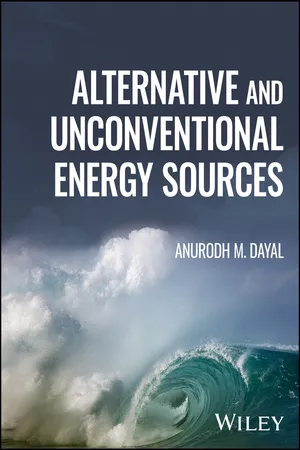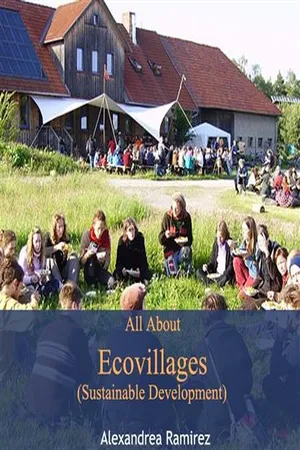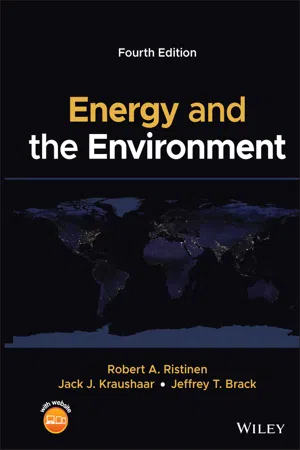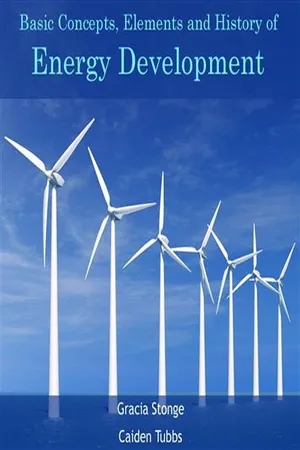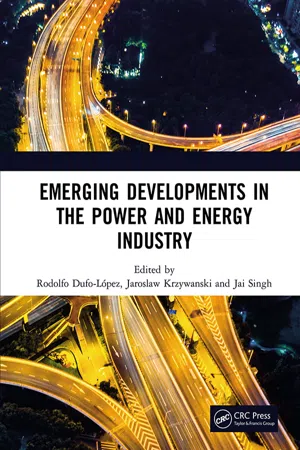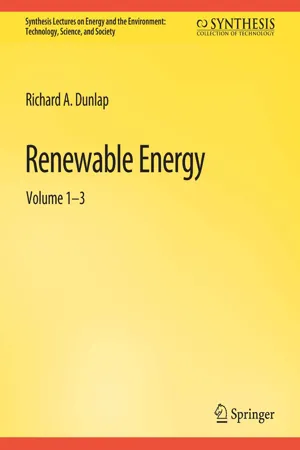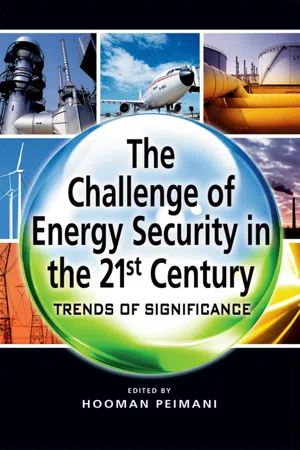Geography
Alternative Energy
Alternative energy refers to sources of power that are renewable and environmentally friendly, such as solar, wind, hydroelectric, and geothermal energy. These energy sources are considered alternatives to traditional fossil fuels like coal, oil, and natural gas. They are important in reducing greenhouse gas emissions and mitigating the impacts of climate change.
Written by Perlego with AI-assistance
Related key terms
1 of 5
12 Key excerpts on "Alternative Energy"
- No longer available |Learn more
- (Author)
- 2014(Publication Date)
- Academic Studio(Publisher)
____________________ WORLD TECHNOLOGIES ____________________ Chapter- 10 Alternative Energy in Society Offshore wind turbines near Copenhagen Alternative Energy in society is an umbrella term that refers to any source of usable energy intended to replace fuel sources without the undesired consequences of the replaced fuels. The term alternative presupposes a set of undesirable energy technologies against which alternative energies are contrasted. As such, the list of energy technologies excluded is an indicator of what problems that the alternative technologies are intended to address. Controversies regarding dominant sources of energy and their alternatives have a long history. The nature of what was regarded Alternative Energy sources has changed considerably over time, and today, because of the variety of energy choices and differing goals of their advocates, defining some energy types as alternative is highly con-troversial. In a general sense in contemporary society, Alternative Energy is that which is produced without the undesirable consequences of the burning of fossil fuels, such as high carbon dioxide emissions, which is considered to be the major contributing factor of global warming according to the Intergovernmental Panel on Climate Change. Sometimes, this less comprehensive meaning of Alternative Energy excludes nuclear energy (e.g. as defined in the Michigan Next Energy Authority Act of 2002). ____________________ WORLD TECHNOLOGIES ____________________ Definitions Source Definition Oxford Dictionary energy fuelled in ways that do not use up natural resources or harm the environment. Princeton WordNet energy derived from sources that do not use up natural resources or harm the environment. Responding to Climate Change 2007 energy derived from nontraditional sources (e.g., compressed natural gas, solar, hydroelectric, wind). - No longer available |Learn more
- (Author)
- 2014(Publication Date)
- White Word Publications(Publisher)
Ethanol fuel is also widely available in the USA. While many renewable energy projects are large-scale, renewable technologies are also suited to rural and remote areas, where energy is often crucial in human development. Globally, an estimated 3 million households get power from small solar PV systems. Micro-hydro systems configured into village-scale or county-scale mini-grids serve many ________________________ WORLD TECHNOLOGIES ________________________ areas. More than 30 million rural households get lighting and cooking from biogas made in household-scale digesters. Biomass cookstoves are used by 160 million households. Climate change concerns, coupled with high oil prices, peak oil, and increasing government support, are driving increasing renewable energy legislation, incentives and commercialization. New government spending, regulation and policies helped the industry weather the global financial crisis better than many other sectors. Overview 2008 worldwide renewable-energy sources. Renewable energy flows involve natural phenomena such as sunlight, wind, tides, plant growth, and geothermal heat, as the International Energy Agency explains: Renewable energy is derived from natural processes that are replenished constantly. In its various forms, it derives directly from the sun, or from heat generated deep within the earth. Included in the definition is electricity and heat generated from solar, wind, ocean, hydropower, biomass, geothermal resources, and biofuels and hydrogen derived from renewable resources. Renewable energy replaces conventional fuels in four distinct areas: power generation, hot water/ space heating, transport fuels, and rural (off-grid) energy services: ________________________ WORLD TECHNOLOGIES ________________________ • Power generation . Renewable energy provides 18 percent of total electricity generation worldwide. - eBook - ePub
- Anurodh M. Dayal(Author)
- 2024(Publication Date)
- Wiley(Publisher)
11 The Development of Alternative Energy Sources and the Global Economy11.1 Introduction
A number of sources for renewable energy are available to replace the conventional energy system. Our aim is to find a way to use these energy sources to provide a better climate for future generations. Solar energy received from the sun is the main source of energy, which is available at least 8–12 hours a day. The intensity of the solar energy is highest at the equator and reduces as we move towards the poles. However, at the poles it is available in the summer for 16–18 hours in a day. For agriculture, solar pumps can replace existing fossil fueled pumps and can be operated 4–5 hours a day. Wind energy is another source of energy. It is also available in a large quantity specifically all along the coast, in the desert, and in hilly regions. Wind energy is well developed and there are several companies that are manufacturing wind turbines. In the long term wind energy will be the only option other than solar energy.Geothermal energy is a very good natural source of energy but is only available in some tectonic zones. For a geothermal power plant, a well is drilled into the surface of the Earth to captures the rising hot steam and water. The hot water and steam are used to run a turbine, and a generator produces electricity, which is connected to power lines. Geothermal power generation is an environmentally sustainable and renewable resource of energy. Nuclear or atomic energy is also used to generate electricity. Atomic energy plants contain highly active radiogenic isotopes, which are in various forms of atoms comprised of the same chemical elements, to generate heat. The fission or fusion of two radiogenic isotopes releases a large amount of heat energy, which can be used to generate electricity. Besides generating power, atomic energy is also used to improve and expedite food production, generate fertilizers, and to increase genetic variability of plants and crops such as sorghum, bananas, beans, and wheat. Atomic energy also facilitates insect control and is used in the field of medicine. - No longer available |Learn more
- (Author)
- 2014(Publication Date)
- University Publications(Publisher)
Ethanol fuel is also widely available in the USA. While many renewable energy projects are large-scale, renewable technologies are also suited to rural and remote areas, where energy is often crucial in human development. Globally, an estimated 3 million households get power from small solar PV systems. Micro-hydro systems configured into village-scale or county-scale mini-grids serve many ________________________ WORLD TECHNOLOGIES ________________________ areas. More than 30 million rural households get lighting and cooking from biogas made in household-scale digesters. Biomass cookstoves are used by 160 million households. Climate change concerns, coupled with high oil prices, peak oil, and increasing government support, are driving increasing renewable energy legislation, incentives and commercialization. New government spending, regulation and policies helped the industry weather the global financial crisis better than many other sectors. Overview 2008 worldwide renewable-energy sources. Renewable energy flows involve natural phenomena such as sunlight, wind, tides, plant growth, and geothermal heat, as the International Energy Agency explains: Renewable energy is derived from natural processes that are replenished constantly. In its various forms, it derives directly from the sun, or from heat generated deep within the earth. Included in the definition is electricity and heat generated from solar, wind, ocean, hydropower, biomass, geothermal resources, and biofuels and hydrogen derived from renewable resources. ________________________ WORLD TECHNOLOGIES ________________________ Renewable energy replaces conventional fuels in four distinct areas: power generation, hot water/ space heating, transport fuels, and rural (off-grid) energy services: • Power generation . Renewable energy provides 18 percent of total electricity generation worldwide. - eBook - PDF
- Frank D. Stacey, Paul M. Davis(Authors)
- 2008(Publication Date)
- Cambridge University Press(Publisher)
26 ‘Alternative’ energy sources and natural climate variations: some geophysical background 26.1 Preamble Solid Earth geophysics offers assessments of energy sources alternative to fossil fuels. We gain some insight on the accessibility and geo-physical effects of exploiting any particular energy source by comparing the contemplated scale of its use with the corresponding natural dissipation. The analyses and discussions of ear-lier chapters are used to address these issues. We consider also the astronomically induced climate variations that must be distinguished from the consequences of fossil fuel use. This is back-ground material to the environmental questions that are primarily problems for atmospheric sci-ence and to the resource question of fossil fuel exhaustion that is a central problem for explora-tion geophysicists. Energy sources considered are solar, wind, tidal, ocean wave, hydroelectric and geothermal, but not nuclear. We neglect also the possibilities of biofuel, merely noting that if it is to make a major contribution it will require a large fraction of the land area to be devoted to appropriate crops. The energy dissipations by various natural processes (Section 26.2 ), give an indication of their availability for exploitation, and especially the magnitudes of their potential contributions. The comparison with the human use of energy draws attention to the fact that human activity is a global geophysical scale phenomenon. This means that major adjustments to it cannot be made easily in a controlled way. But major adjustments to energy use are inevitable and if they are uncontrolled they are likely to be pain-ful. We examine here some of the basic facts that are needed for informed judgements of the pro-blems and potential solutions. Our discussion is restricted to fundamental questions of energy availability in principle and does not address technical problems of exploitation. - eBook - PDF
- Robert A. Ristinen, Jack J. Kraushaar, Jeffrey T. Brack(Authors)
- 2022(Publication Date)
- Wiley(Publisher)
5 Renewable Energy Sources II Alternatives Russell Illi g /Gett y Ima g es, Inc. 5.1 Introduction Solar energy can fulfill our energy needs in many wondrous ways. Aside from the direct uses of solar radiation covered in the last chapter, there are also the less direct technologies of hydroelectricity, wind energy, biomass, ocean thermal gradients, ocean currents, and ocean waves for making use of energy from the sun. In addition to using the energy sources of solar origin, we have also learned how to exploit ocean tides and geothermal resources. These are all renewable energy sources that can be explored to see what potential they have for provid-ing useful amounts of energy in an economically and environmentally sound way. The over-all flow of energy to and from the earth is shown in Figure 5.1. 125 Energy and the Environment , Fourth Edition. Robert A. Ristinen, Jack J. Kraushaar, and Jeffrey T. Brack. © 2022 John Wiley & Sons, Inc. Published 2022 by John Wiley & Sons, Inc. Companion website: www.wiley.com/go/brack/energyandenvironment4thedition 5.2 Hydropower Hydroelectricity is a well-established technology; it dates back to the beginnings of the elec-tric power industry more than 100 years ago. About 7% of the electric power now generated in the United States comes from our damming the rivers as they flow to the ocean and then releasing the water to turn turbines connected to electric generators. The use of water power is much greater in some other countries; Norway obtains 99% of its electricity from water power, Nepal 95%, Brazil 93%, New Zealand 78%, Canada 58%, and Sweden 50% (half hydro, half nuclear). Hydropower was important long before electricity generation became possible. About 2000 years ago, during the first century BCE, it was discovered that the force of moving water acting on a waterwheel could be used to ease human labor. - No longer available |Learn more
- (Author)
- 2014(Publication Date)
- Academic Studio(Publisher)
____________________ WORLD TECHNOLOGIES ____________________ Chapter 1 Introduction to Energy development Schematic of the global sources of energy in 2006. Energy production from 1989 to 1999 Energy development is the effort to provide sufficient primary energy sources and secondary energy forms for supply, cost, impact on air pollution and water pollution, mitigation of climate change with renewable energy. ____________________ WORLD TECHNOLOGIES ____________________ Technologically advanced societies have become increasingly dependent on external energy sources for transportation, the production of many manufactured goods, and the delivery of energy services. This energy allows people who can afford the cost to live under otherwise unfavorable climatic conditions through the use of heating, ventilation, and/or air conditioning. Level of use of external energy sources differs across societies, as do the climate, convenience, levels of traffic congestion, pollution and availability of domestic energy sources. Renewable sources The wind, Sun, and biomass are three renewable energy sources Renewable energy is energy which comes from natural resources such as sunlight, wind, rain, tides, and geothermal heat, which are renewable (naturally replenished.) Renewable energy is an alternative to fossil fuels and nuclear power, and was commonly called Alternative Energy in the 1970s and 1980s. In 2008, about 19% of global final energy consumption came from renewables, with 13% coming from traditional biomass, which is mainly used for heating, and 3.2% from hydroelectricity. New renewables (small hydro, modern biomass, wind, solar, geothermal, and biofuels) accounted for another 2.7% and are growing very rapidly. The share of renewables in electricity generation is around 18%, with 15% of global electricity coming from hydroelectricity and 3% from new renewables. - eBook - PDF
Emerging Developments in the Power and Energy Industry
Proceedings of the 11th Asia-Pacific Power and Energy Engineering Conference (APPEEC 2019), April 19-21, 2019, Xiamen, China
- Rodolfo Dufo-López, Jaroslaw Krzywanski, Jai Singh(Authors)
- 2019(Publication Date)
- CRC Press(Publisher)
3.1 Sustainable development Sustainable energy is the energy that, in its production or consumption, has minimal negative impacts on human health and the healthy functioning of vital ecological systems, including the global environment. It is an accepted fact that renewable energy is a sustainable form of energy, which has attracted more attention during recent years. Increasing environmental interest, as well as economic consideration of fossil fuel consumption and high emphasis of sustainable development for the future helped to bring the great potential of renewable energy into focus Wu, and Boggess (1999). Nearly a fifth of all global power is generated by renew-able energy sources, according to a new book published by the Organisation for Economic Co-operation and Development (OECD)/International Energy Association (IEA) OECD/IEA (2004). ‘‘ Renewables for power generation: status and prospects ’’ claims that, at approxi-mately 20%, renewables are the second largest power source after coal (39%) and ahead of nuclear (17%), natural gas (17%) and oil (8%) respectively. From 1973-2000 renewables grew at 9.3% a year and it is predicted that this will increase by 10.4% a year to 2010. Wind power grew fastest at 52% and will multiply seven times by 2010, overtaking biopower and hence help reducing green house gases, GHGs, emissions to the environment. 4 RESULTS AND DISCUSSIONS The availability of data on solar radiation is a critical problem. Even in developed countries, very few weather stations have been recording detailed solar radiation data for a period of time long enough to have statistical significance. Solar radiation arriving on earth is the most fundamental renewable energy source in nature. It powers the bio-system, the ocean and atmospheric current system and affects the global climate. - eBook - PDF
Renewable Energy
Volumes 1 – 3
- Richard A Dunlap(Author)
- 2022(Publication Date)
- Springer(Publisher)
• Available power. All sources of energy are limited to some extent. The amount of power available from a given source will determine its maximum possible contribution to our total energy consumption. • Longevity. The length of time a resource will last depends on the total amount of en- ergy available. While we view renewable energy as renewable indefinitely, this may not always be the case. • Environmental impact. While renewable energy production may not directly produce CO 2 emissions, some may contribute to the greenhouse gas balance in the atmosphere as a result of geographical changes that produce greenhouse gases, such as methane, or reduce the natural sequestration of carbon dioxide. Other impacts may include effects on wildlife and direct or indirect effects on human health. 40 3. RENEWABLE ENERGY SOURCES • Economics. The cost of renewable energy sources is a factor in determining the time scale for their development. At present, fossil fuels are still plentiful and inexpensive. This fact motivates their continued use and may delay the development of potentially viable, but more expensive, renewable sources. Additional factors that may influence the development of certain renewable energy sources include social perception, political agendas, security, and safety. There are a number of options for carbon-free energy and the present chapter concentrates on the five that have made the greatest contribution thus far to carbon-free energy production and are likely to continue to do so in the foreseeable future. These energy sources are: hydroelectric, solar, wind, geothermal, and biofuels. Several other approaches to renewable energy are in the early stages of development and may make important contributions to our energy needs at some point in the future. These approaches include: tidal energy, wave energy, ocean thermal energy conversion, and osmotic energy. For the present discussion, nuclear energy is not considered renewable. - eBook - PDF
The Challenge of Energy Security in the 21st Century
Trends of Significance
- Hooman Peimani(Author)
- 2011(Publication Date)
- ISEAS Publishing(Publisher)
8 Benjamin K. Sovacool 2 GLOBAL TRENDS IN RENEWABLE ELECTRICITY, RENEWABLE FUELS, AND MARKETS FOR RENEWABLE HEATING AND COOLING Benjamin K. Sovacool 1. INTRODUCTION Renewable resources of energy have immense potential to supply a much larger fraction of the world’s electricity, fuel for transportation, and heat and other energy services. Renewable energy can be utilized through a variety of sources, approaches, systems, and technologies: • Plants and algae require sunlight for photosynthesis before they can be converted to biofuels or biopower; • Hydropower capitalizes on rain and snowfall resulting from water evaporation and transpiration; • Wind generates electricity directly by turning a turbine, or indirectly in the form of ocean waves, but the wind itself is driven by the sun; • Tidal and geothermal energy are the only renewable energy resources that are not a direct result of solar energy. Tides rise and fall due to the Global Trends in Renewable Energy Resources 9 gravitational attraction between the oceans and the moon. The heat trapped in the earth itself is due to both leftover heat from the formation of the planet, and the radioactive decay of elements within the crust, such as uranium and thorium. When the potential for these energy sources is quantified, the numbers are startling. One recent assessment, which collected actual data on wind speeds (at a hub height of 80 metres) at 7,753 surface stations, identified about 72 terawatts (TW) of potential. 1 One fifth of this potential could satisfy 100 per cent of the world’s energy demand and more than seven times its electricity needs. 2 If we exclude biomass and look at solar, wind, geothermal, and hydroelectric energy resources, the world has roughly 3,439,685 terawatt-hours (TWh) of potential — about 201 times the amount of electricity the world consumed in 2007 (see Table 2.1). 3 So far, less than 0.09 per cent of the potential for renewable energy to meet global energy needs has been harnessed. - eBook - PDF
- Brian C. Black, Richard Flarend(Authors)
- 2010(Publication Date)
- Greenwood(Publisher)
In fact, as soon as one begins to administer energy under the guise of sustainability and doing things well, the topic must turn to Alternative Energy. This volume looks at one specific segment of this transition: alternative forms of energy. Many experts believe these methods for harvesting energy promise the most likely paradigm for future development. Or, at least, they represent a segment of our energy use that must slowly—and strategically— expand and incrementally replace our use of fossil fuels. As one begins to forecast the future of alternative fuels, he or she can’t help but also cast a look backward to the history of such energy sources. With even a passing glance backward, it becomes obvious that there is a long and complex history related introduction xix to the emergence of Alternative Energy. Often, these are very old technologies used in a new fashion. Most important, contained within the very terminol- ogy of the name of these sources of power is their basic reality: To what are these energy sources an alternative? Fossil fuels, which currently supply about 85 percent of our energy, are all concentrated in locations that are out of view of the general public. The environmental impact of extracting these energy sources goes unseen, not to mention that most waste emissions are dumped into the atmosphere and rivers in invisible amounts—but not with invisible harm. The economic and environmental costs of these emissions, not to mention the societal impact of this extraction of energy, is not factored into the consumer cost of electricity or gasoline. Therefore, the chain of connectivity between the extraction and supply of energy to society and the resulting negative impact on society is broken. Many scholars have sought to create a more complete accounting of energy production. In short, to prove the point, a single place must currently absorb or suffer from much of the cumulative environmental or social effects caused by the extraction of energy. - eBook - PDF
Our Energy Future
Introduction to Renewable Energy and Biofuels
- Carla S. Jones, Stephen P. Mayfield(Authors)
- 2016(Publication Date)
- University of California Press(Publisher)
This difference in solar irra-diance between these regions represents a potential differ-ential in price and availability of power. Homes in the northeast may need to continue supplementing power gen-erated from fossil fuels to meet their needs, while homes in the southwest that can produce more power than needed can get paid to put their extra power into the electric grid. While the installation costs today may keep some people from installing this technology, the continued decrease in the price of the technology, coupled with the ever-increas-ing price of fossil fuel electricity, will likely help push more people to use photovoltaics. Developing cheap and efficient methods to store photovoltaic power and creating a more ecologically sustainable process for solar cell generation would also allow photovoltaics to play a much larger role in the future of renewable energy. Wind Energy Wind is another renewable energy source that is ultimately derived from the sun. At first this may not seem intuitive, but the regional heating of the Earth by the sun generates wind. Warm air will rise, leading to a void that then pulls the cooler air in to replace the rising warm air. As this air rushes in, wind is created (Olanrewaju, 2011). This process is evident on a global scale by studying hemispheric wind patterns. As depicted in figure 4.6, in the tropics near the equator, the sun is intense and heats the air, resulting in warm, moist tropical air. This air rises into the atmosphere near the equator in what is known as the intertropical con-vergence zone. However, this rising warm air must also be replaced by cooler air located closer to the Earth’s surface in the subtropical regions. Subtropical cool air drops below the tropical warm air to create the Easterlies or Trade winds often found in the tropics and subtropics. Wind can also be created on a much smaller regional scale as seen with ocean front climates.
Index pages curate the most relevant extracts from our library of academic textbooks. They’ve been created using an in-house natural language model (NLM), each adding context and meaning to key research topics.


